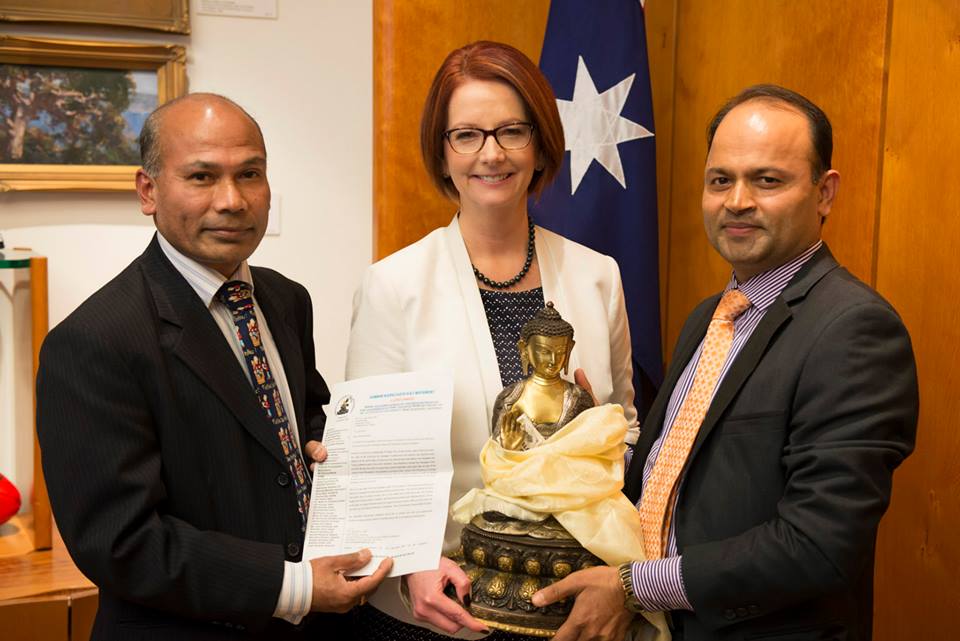Australia: Immigrant professionals with non-skilled job to be prioritized
Posted by Ram Kumar Shrestha on September 5, 2011
[Although this is written in the context of Australia, the same problem remains in other developed countries as well.]
By Ram Kumar Shrestha
Australia is one of the most multicultural countries in the world. Statistics indicate that around one quarter of the Australian population were born overseas and almost half (around 40%) have at least one parent born overseas. This is the broad context that frames the importance of comprehending the scale and nature of the social costs and benefits of migration into Australia.1 Cultural diversity is, hence, not only its gorgeousness but also special affluence. This special mosaic of the country strongly suggests being very serious on this issue for the benefit of all immigrants and eventually of the whole country.
Australian population were born overseas and almost half (around 40%) have at least one parent born overseas. This is the broad context that frames the importance of comprehending the scale and nature of the social costs and benefits of migration into Australia.1 Cultural diversity is, hence, not only its gorgeousness but also special affluence. This special mosaic of the country strongly suggests being very serious on this issue for the benefit of all immigrants and eventually of the whole country.
The original aim of the Australia’s migration program was to build up the population for defense purposes. In the 1950s and 1960s, the program aimed to bring in workers to build up Australia’s manufacturing industries. By the early 1990s, the aims of the program were more diffuse, encompassing social (family reunification), humanitarian (refugee and humanitarian migration) as well as economic (skilled migration) objectives. Over the last ten years the emphasis of the program has been on skilled migration (both temporary and permanent), particularly to our regional areas.2 Business expansion, expansion of government services, new business developments, contributions to technology, additional productive diversity through knowledge of international business markets etc are some major advantages of the program. Australia’s economic growth is, hence, significantly enhanced due to the program as migrants directly impact on the economy through their contributions to supply and demand and their indirect contribution to government surpluses.
Today, the Department of Immigration and Multicultural Affairs (DIMA) allocates around 130 000 to 140 000 migration places each year—the highest level in twenty years—with a firm focus on bringing in migrants with the relevant skills to complement Australia’s labor market needs and skill shortages. In 2005-06, 97 500 places have been allocated for skilled migration.3 In this scientific epoch to make productive economy possible with better rate to compete with other countries skilled labors migration strategy is a must for a country with least densely populated countries like Australia and without this, standard of living of the country as a whole could not be possible. Keeping these in mind, DIMA seems to come in this decision.
Australia could face a serious shortage of skilled workers within the next 15 years if steps are not taken to address the issue, a new report has warned. According to the Workplace Futures Report, which was written by the Victorian Employers’ Chamber of Commerce and Industry (VECCI) and is based on official data, the proportion of the Australian population in work is set to drop from 65.2 per cent to 61.8 per cent by 2025, largely as a result of ageing.
With the report noting that in order to meet even moderate levels of labor-demand growth, a participation rate of 68 per cent is needed, the country could soon be suffering from a shortfall equivalent to 1.4 million workers.4
Net migration to Australia is in free fall. In two years, migration has plunged by almost half, intensifying the skills shortages that threaten to drive up interest rates. The Bureau of Statistics reports that net migration was just 171,000 in 2010, down sharply from 316,000 in 2008, and the lowest since the bureau changed its measuring system in late 2006.5
In practice, it seems that immigrant professionals’ involvement in non-skilled job exists in every developed country. Rate of joblessness in Australia is highest among immigrants coming to Australia to work here. A large percentage of immigrants wanting to work in Australia are unemployed. The ABS figures reveal a total of 5.2 percent of Australian population is without any jobs in Australia presently and the number of skilled immigrants without having jobs in Australia is a whopping 7.3 percent.6 To prepare a skilled labor force, it takes years and costs hundreds of thousand dollars and it is clear that lots of available skilled labors are involved in non-skilled works despite their need in the country. Isn’t it bizarre and horrendous?
In contrast, Australia experienced its biggest annual exodus on record with 76 923 people leaving the country permanently in 2007-08. The Emigration 2007-2008 report reveals that almost half the Australian residents that left permanently were in skilled jobs and nearly two thirds were aged between 25 and 54. A further 102 066 Australian residents left the country for a year or more with more than 55 per cent in professional occupations or trades. The data showed that emigration played a significant role in Australia’s current skills shortage.7
These very serious but quite controversial facts strongly suggest Australian government should develop system or model or mechanism that could help to sort out or at least minimize these problems in the future. That would, undoubtedly, be beneficial not only for the economical development of the country but also for the socio-economic and psychological betterment of many immigrant professionals and their friends and families and eventually of the whole country.
With the help of some studies and programs it could be possible to develop pertinent model or mechanism for Australian government to bring immigrant professionals with non-professional jobs within a network and create favorable environment to dig up their own professional job as per their qualification and experience. And this is very important time relevant demand especially in the context of Australia due to the facts mentioned above.
Reference:
- The Social Costs and Benefits of Migration into Australia; http://www.immi.gov.au/media/publications/research/social-costs-benefits/contents_exec_summary_and_intro.pdf
- Skilled Migration to Australia; http://www.aph.gov.au/library/intguide/sp/skilled_migration.htm
- Skilled Migration to Australia; http://www.aph.gov.au/library/intguide/sp/skilled_migration.htm
- Australia set for skilled worker shortage, report warns; http://www.randstad.com/the-world-of-work/australia-set-for-skilled-worker-shortage-report-warns?c=5650
- Colebatch, Tim; Immigration numbers plunge by almost half; http://www.theage.com.au/national/immigration-numbers-plunge-by-almost-half-20110623-1ghjc.html
- Joblessness higher among immigrants in Australia: http://www.canadaupdates.com/content/joblessness-higher-among-immigrants-australia-15711.html
- Australia’s brain drain biggest on record; http://www.minister.immi.gov.au/media/media-releases/2008/ce08098.htm
















































Most Visited Blog said
Great article. Thanks dude. Keep it up!
http://www.musicindustrycareers.org said
Thanks I have been looking for more info on the topic discussed on this site. again thanks.